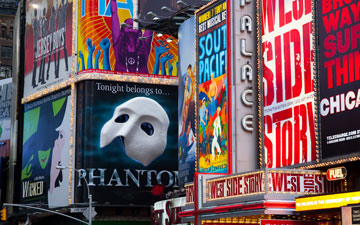Broadway engages the Twitterati

Anyone who has been to a movie in the last few years has likely been subjected to the annoying sight and sound of someone texting away on their cell phone. Despite a range of admonishments from cutesy to the simple "don't do it" many people seem to be constitutionally incapable of disconnecting themselves from the social universe for the length of a movie. Of course, theatres are good about stamping out this behavior and a customer complaint will often see the offending party removed.

The show was the current hit revival of Stephen Schwartz's Godspell, now playing at the Circle in the Square; a small, intimate theatre by today's Broadway standards. And given that the performance is in the round, the idea of putting the tweeters in an out of the way corner just couldn't work.
Godspell is already hooked into the social media world; they have @GodspellGirl on staff (and with a Playbill credit) She welcomes theatregoers, gives tours, tweets about celebrities attending a performance and basically gives her followers a real-time window into what is going on with the performance every night, direct from her Godspell-branded iPad.
Before the show, Ken Davenport, producer of Godspell, said on the show's blog site "At Godspell, we have some of the most passionate Twitter users I've ever seen on a Broadway show, so we thought this would be the perfect opportunity to reward them for the tweeting they've done, and also to test the concept of ‘Tweet Seats' in a Broadway theater."
To this end, they gave tickets to 18 of their most Twitter-savvy fans, put them all in one back row, and gave them some instructions on how to behave re their Twittering; rules that basically said, keep the brightness down, turn off the sound, and since you've all seen the show before, cover the screens during the parts you know the house is dark.
I spoke to Ken this week and asked him if he thought the experiment was a success. He responded that "the most important thing to him was that the Tweeters had a great time; that they enjoyed the experience and enjoyed the show. And that they were successful in tweeting their experience without disrupting other theatergoers." Ken pointed out that he had taken twenty or so other theatergoers aside and asked them if the Tweet Seats had impacted their experience; none of the people he talked to were even aware that the live tweeting had been going on.
Natalie, my 21 year old daughter was one of the "passionate twitter users" selected for this experiment. She's a theater major and definitely very serious about what she hopes will be her professional craft. She's also an excellent representative of a generation that considers social media an integral part of their day to day life, with active accounts on any platform that matters (she even got a Google + account long before they would let me and most of my technology journalist buddies in). These were some of the things she had to say about the evening:
"Live-tweeting the show isn't something I would've done if I'd never seen it before; I quickly discovered it was definitely a challenge splitting my attention between the show and my phone. There were two times when I stopped tweeting entirely because I wanted to focus on what was happening onstage instead"
"A lot of complaining and debating was happening in the Twitter-verse as the show went on; someone even threatened to punch a TweetSeat-er in the neck because she so disagreed with the concept of Tweeting during a live performance. "
"The show's cast, crew, and band were all aware of what was going on and a few of them even referenced us during the performance. During "Turn Back, O Man" (which we referred to as #TweetBackOMan) one of the actors ad-libs was "I'll give ya somethin' to tweet about!" "
"When we met the actors after the performance they all made mention of how cool they thought it was and how much they'd enjoyed reading our tweets during intermission and that they were looking forward to catching up on Act II when they got home that evening."
Davenport is one of the youngest Broadway producers; to him, the technical side of social media seems to be second nature. In his words "Broadway should be the leader"; it's the center of the live theater universe and Ken believes that they need to take advantage of technology much more quickly than it has been adopted in the past.
One thing I talked to him about was how the nature of the show being tweeted about would impact doing something like this. As my daughter and Ken pointed out, the interactive nature of the piece meant that the actors could comment on the activity and integrate it with the performance.
When I asked him about the impact of audiences tweeting or texting during shows he was very clear in stating that it should be controlled and regulated. He was in no way advocating any sort of unrestrained use of phones during shows, but felt that with the proper use, theaters could both regulate and benefit from technologies such as Twitter. And Ken made one incredibly important point; the average age of the Broadway theatergoer is 44 years old. The average age of his passionate Twitterers was only 21.
Getting younger people into the theater is the only way to assure Broadway's relevance, if not its very survival, in an age where entertainment is at everyone's fingertips. And I look forward to Mr. Davenport's next experiment.